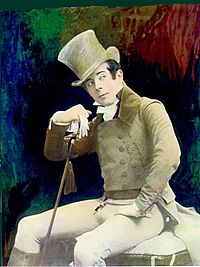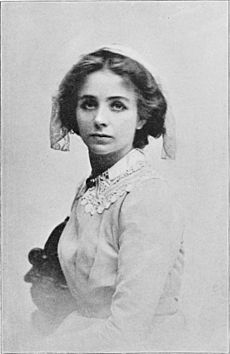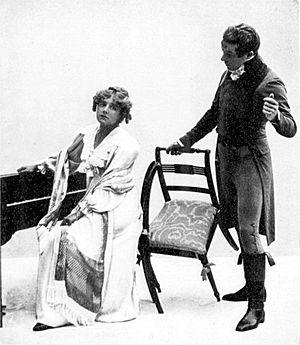Quality Street (play) facts for kids
Quick facts for kids Quality Street |
|
|---|---|

Illustration of Seymour Hicks as Valentine Brown
|
|
| Written by | J. M. Barrie |
| Characters | See below |
| Date of premiere | November 11, 1901 |
| Place of premiere | Knickerbocker Theatre |
| Original language | English |
| Genre | Comedy |
| Setting | Napoleonic times |
Quality Street is a funny play written by J. M. Barrie. He wrote it before his super famous story, Peter Pan. This play is about two sisters who decide to open a school. They teach "genteel children," which means kids from good families.
The play first opened in New York City in 1901. It ran for 64 shows. Later, it moved to London and became a huge hit! It played 459 times there. People loved Quality Street and brought it back many times until World War II.
Contents
Main Characters and Original London Actors
Here are some of the main characters in Quality Street and the actors who played them in London in 1902:
- Valentine Brown – He wants to marry Miss Phoebe. Played by Seymour Hicks.
- Miss Phoebe Throssel – A school teacher who dreams of love. Played by Ellaline Terriss.
- Miss Livvy – Phoebe's fun and flirty secret identity. Also played by Ellaline Terriss.
- Susan Throssel – Phoebe's sister, who helps run the school. Played by Marion Terry.
- Patty – The helpful maid who works for the Throssel sisters. Played by Rosini Filippi.
- Ensign Blades and Lieutenant Spicer – Young officers.
- Miss Willoughby and Miss Fanny Willoughby – Local ladies.
The Story of Quality Street
The play takes place a long time ago, during the time of Napoleon.
Act 1: A Proposal That Isn't
Everyone in town is talking about Miss Phoebe Throssel and Valentine Brown. They think he's going to ask her to marry him! Phoebe tells her sister, Susan, that Valentine is coming over. Both sisters are sure he will propose.
But when Valentine arrives, he doesn't ask Phoebe to marry him. Instead, he tells them he's going to join the army. He wants to fight against Napoleon in Europe. This news makes Phoebe and Susan very sad.
Act 2: The School and a New Identity
Ten years pass after Valentine leaves. Phoebe and Susan have opened a school to earn money and pay their rent. Phoebe hasn't married anyone else. She has become a "spinster," which means an unmarried woman, and a school teacher.
Phoebe misses her younger days. When Captain Brown returns, it makes her feel even more sad. She says she's "tired of being lady-like." With some help from her maid, Patty, Phoebe creates a new, secret person: Miss Livvy. Miss Livvy is a fun, flirty, and a bit naughty version of Phoebe's younger self. Phoebe starts to tease Captain Brown as Miss Livvy. He is charmed by her and asks her and Susan to go to a ball with him.
Act 3: The Ball and a Realization

At the ball, Phoebe is still pretending to be Miss Livvy. As Miss Livvy, she gets a lot of attention from young men. But the other ladies are not happy with her. Phoebe starts to get annoyed that Captain Brown seems to like Miss Livvy more than her true self.
Things get tricky when local gossips, Fanny Willoughby and Henrietta Turnbull, almost discover Phoebe's secret. Finally, Captain Brown talks to Phoebe. He tells her he loves the real Miss Phoebe, not the made-up Miss Livvy. He says, "I have discovered for myself that the schoolmistress in her old maid's cap is the noblest Miss Phoebe of them all."
Act 4: The Truth Comes Out
Miss Livvy is still a problem for the sisters. Now that she's been created, it's hard to make her disappear! The town gossips are always watching for any sign of Miss Livvy. They often visit the sisters' home.
Captain Brown comes to ask Phoebe to marry him again. But she turns him down without explaining why. Because of this, he figures out her disguise and understands the sisters' difficult situation. He then decides to fix everything, including his own past mistakes.
Play Productions
Quality Street first opened on October 11, 1901, in Toledo, Ohio. It then came to New York City on November 11, 1901, at the Knickerbocker Theatre. Charles Frohman produced it, and Maude Adams starred in it. It ran for 64 shows, which was okay but not a huge success in New York.
However, when it opened in London on September 17, 1902, at the Vaudeville Theatre, it was a massive hit! It ran for 459 shows. Ellaline Terriss, Seymour Hicks, and Marion Terry were the stars. This made it one of the first American plays to be more successful in London than in New York.
The play was brought back many times and went on tour until World War II. It was revived in London in 1913 at the Duke of York's Theatre. In New York, Maude Adams starred in a short revival in 1908 at the Empire Theatre. Other revivals happened in America into the 1920s.
In 2010, the Finborough Theatre in London put on the first professional production of the play in London in over sixty years.
In 2020, a theater company called Northern Broadsides performed the play. It was at the Viaduct Theatre in Halifax. The director was Laurie Sansom. This version also included comments from people who work at the Quality Street chocolates factory today. The play toured to other cities like Salford, Lancaster, and Bury St Edmunds. But it had to stop early because of the coronavirus pandemic.
Film and Other Adaptations
Quality Street was made into a movie twice:
- The first movie was in 1927 and starred Marion Davies.
- The second movie was in 1937 and starred Katharine Hepburn.
A musical version of the play, called Dear Miss Phoebe, was created in 1950. It was written by Christopher Hassall and Harry Parr Davies.
Legacy: Chocolates and a Street Name
The play was so popular that the famous Quality Street chocolates and caramels were named after it! The candy company even used characters from the play in their early ads and on their packaging.
When the actors Seymour Hicks and Ellaline Terriss moved to a new home in Merstham, Surrey, their street was renamed "Quality Street."
- Quality Street at the Internet Broadway Database
- Quality Street at Theatricalia.com


